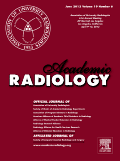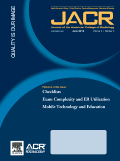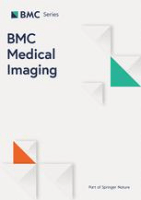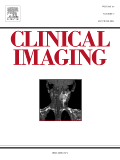
ACADEMIC RADIOLOGY
Scope & Guideline
Leading the Charge in Imaging Excellence
Introduction
Aims and Scopes
- Artificial Intelligence and Machine Learning in Radiology:
Research focusing on the application of AI and machine learning algorithms to improve diagnostic accuracy, automate processes, and enhance image analysis in radiology. - Radiomics and Imaging Biomarkers:
Studies exploring the extraction of quantitative features from medical images (radiomics) to predict clinical outcomes, treatment responses, and disease characteristics. - Clinical Applications of Imaging Techniques:
Papers discussing the use and effectiveness of various imaging modalities (CT, MRI, PET, ultrasound) in diagnosing and managing specific medical conditions. - Educational Innovations in Radiology:
Research aimed at improving medical education and training in radiology, including curriculum development, mentorship programs, and the use of technology in teaching. - Healthcare Disparities and Patient-Centered Care:
Investigations into the impact of socioeconomic factors on access to radiological services and outcomes, focusing on improving equity in healthcare delivery. - Burnout and Wellness in Radiology:
Research addressing the mental health, job satisfaction, and work-life balance of radiologists, with recommendations for promoting wellness in the profession.
Trending and Emerging
- Integration of AI in Radiology:
There is a significant increase in research focusing on the integration of artificial intelligence in radiology, particularly in automating image analysis and improving diagnostic accuracy. - Radiomics and Predictive Modeling:
The use of radiomics to develop predictive models for treatment outcomes and disease progression is a rapidly growing area, indicating a shift towards personalized medicine. - Telehealth and Remote Education:
The COVID-19 pandemic has accelerated research on telehealth and remote education initiatives, highlighting their importance in maintaining continuity and accessibility in radiology. - Interdisciplinary Collaboration:
Emerging themes emphasize interdisciplinary approaches, integrating radiology with other medical specialties to enhance patient care and research outcomes. - Health Equity and Diversity in Radiology:
There is a growing focus on addressing health disparities and promoting diversity within the field, reflecting societal changes and the need for inclusive practices.
Declining or Waning
- Traditional Imaging Techniques:
There is a noticeable decline in research centered around conventional imaging techniques without the integration of advanced technologies, as newer methodologies gain traction. - Generalized Clinical Protocols:
The focus on broad, generalized clinical protocols is decreasing, as more personalized, patient-specific approaches become the standard in clinical practice. - Basic Radiology Education:
Papers focusing solely on basic radiology education are becoming less frequent, as the emphasis shifts towards more advanced and specialized training methodologies. - Single-Center Studies:
The prevalence of single-center studies is declining in favor of multicenter collaborations that provide broader insights and generalizability. - Non-Quantitative Imaging Analysis:
Research that does not incorporate quantitative analysis or advanced imaging biomarkers is becoming less common, as the field emphasizes data-driven approaches.
Similar Journals

Journal of the American College of Radiology
Empowering Radiology Through Insightful ResearchJournal of the American College of Radiology, published by ELSEVIER SCIENCE INC, stands as a premier platform for researchers, professionals, and students in the dynamic field of radiology, nuclear medicine, and imaging. With an impressive impact factor and ranked in the top quartile (Q1) for its category in 2023, this journal is dedicated to advancing knowledge and innovation through high-quality research and insightful clinical contributions. The journal covers a wide range of topics within radiology, ensuring that it remains at the forefront of the discipline's evolving landscape. As an essential resource for those engaged in academic inquiry and clinical practice, the Journal of the American College of Radiology is committed to disseminating pivotal findings that shape patient care and inform best practices, while also providing insightful perspectives on pressing issues in medical imaging. Scholars looking to contribute to this prestigious journal can access it securely, with an established history since its inception in 2004 and a robust future outlook through 2024, securing its vital role in the ongoing dialogue within the medical community.

Insights into Imaging
Shaping the Future of Medical Imaging ResearchInsights into Imaging is a prominent open-access journal published by SPRINGER WIEN, specializing in the dynamic fields of radiology, nuclear medicine, and imaging, with its ISSN 1869-4101. Established in 2012, the journal has established itself as a leading platform for disseminating high-quality research and innovative findings, currently holding a prestigious Q1 ranking in its category as of 2023. With an impressive Scopus rank of #42 out of 333 in the medicine discipline, the journal is positioned in the 87th percentile, reflecting its significance and influence in the academic community. Based in Germany, Insights into Imaging not only provides unrestricted access to research but also aims to bridge the gap between scientific inquiry and clinical application, making it an essential resource for researchers, professionals, and students engaged in advancing imaging technologies and practices. The journal’s commitment to fostering knowledge exchange ensures that it remains a critical contributor to the evolving landscape of medical imaging, with articles available from 2012 through 2024.

BMC MEDICAL IMAGING
Exploring Cutting-edge Techniques in Radiology and Nuclear Medicine.BMC Medical Imaging is a premier open-access journal dedicated to advancing the field of radiology, nuclear medicine, and imaging technologies. Published by BMC in the United Kingdom, this journal serves as a vital resource for researchers, clinicians, and students, fostering a collaborative environment for sharing innovative findings and methodologies in medical imaging. With a commendable impact factor and an impressive Scopus ranking within the top 35% of its category, BMC Medical Imaging provides a platform for high-quality research to be disseminated widely and freely since its inception in 2001. The journal aims to cover a diverse array of topics, from advanced imaging techniques to their clinical applications, enhancing the understanding and effectiveness of diagnostic practices. By contributing to the body of knowledge and facilitating open access to research, BMC Medical Imaging plays a pivotal role in shaping the future of medical imaging and improving patient care.

Radiologie
Pioneering Research in Radiology and Imaging TechnologyRadiologie, published by SPRINGER HEIDELBERG, is an emerging journal dedicated to the fields of radiology, nuclear medicine, and imaging. With an ISSN of 2731-7048 and E-ISSN 2731-7056, this journal does not currently offer open access, providing a traditional yet respected platform for scholarly communication. Founded in 2022, it aims to advance the understanding of cutting-edge imaging techniques and their applications in clinical practice, contributing to improvements in diagnostic accuracy and patient care. Despite its recent establishment, Radiologie is positioned within the Q4 quartile category, reflecting its developing presence in the academic landscape, with a current Scopus rank of #231 out of 333 in its category. The journal serves as a vital resource for researchers, professionals, and students seeking to stay abreast of the latest developments in radiological science, imaging technology, and their clinical implications, ensuring ongoing engagement and advancement in this critical area of healthcare.

Japanese Journal of Radiology
Unveiling the Future of Radiology, One Article at a TimeThe Japanese Journal of Radiology, published by SPRINGER, serves as a premier platform for disseminating cutting-edge research and clinical advancements in the fields of radiology, nuclear medicine, and imaging. With an ISSN of 1867-1071 and E-ISSN 1867-108X, this journal has established itself as a vital resource for practitioners, researchers, and students alike. Renowned for its high-quality peer-reviewed articles, it currently enjoys a respectable impact factor within the Q2 category of Scopus rankings, placing it in the 69th percentile among 333 journals in its field. The journal has seen consistent convergence of research from 2009 to 2024, further underscoring its commitment to advancing the understanding of radiological practices. Importantly, the journal offers Open Access options to facilitate widespread dissemination of knowledge, ensuring that vital research reaches its audience without barriers. Addressed in Japan, the Japanese Journal of Radiology plays a critical role in enhancing the global discourse on medical imaging, making it an essential resource for anyone engaged in this dynamic field.

Clinical Imaging
Bridging Research and Practice in RadiologyClinical Imaging, published by Elsevier Science Inc, is a renowned journal dedicated to the field of radiology, nuclear medicine, and imaging. With an ISSN of 0899-7071 and an E-ISSN of 1873-4499, this esteemed publication has established its significance in advancing imaging science since its inception in 1989 and continues to make impactful contributions to the discipline through 2024. The journal holds a prestigious Q2 ranking in the category of Radiology, Nuclear Medicine, and Imaging, reflecting its critical role in bridging research and clinical practice. Currently ranked #113 out of 333 by Scopus, with a notable 66th percentile, it offers a platform for disseminating high-quality research, reviews, and case studies that inspire innovation and enhance imaging techniques. Although it primarily functions as a subscription-based journal, it remains dedicated to accessibility and the dissemination of pivotal findings that inform both academia and clinical settings. Clinical Imaging is essential for researchers, professionals, and students alike, offering insights that shape the future of diagnostic imaging.

Egyptian Journal of Radiology and Nuclear Medicine
Unlocking the Future of Imaging and TherapyThe Egyptian Journal of Radiology and Nuclear Medicine, published by Springer, is a premier open access journal that has provided valuable insights and advancements in the fields of radiology and nuclear medicine since its initiation in 2010. With an E-ISSN of 2090-4762, this journal is dedicated to bridging the gap between research and clinical practice, allowing for the dissemination of high-quality research to a global audience. Situated in Germany, it enjoys a robust reputation in the academic community, evidenced by its categorization in the Q3 quartile for 2023, as well as its Scopus ranking, where it holds a position of #225 out of 333 in the domain of Radiology, Nuclear Medicine and Imaging, placing it in the 32nd percentile. The journal's open access model ensures that researchers, professionals, and students can freely access innovative studies, reviews, and case reports that discuss the latest methodologies, technological advancements, and clinical outcomes in radiology and nuclear medicine. As it looks toward its converged years spanning from 2010 to 2024, the Egyptian Journal of Radiology and Nuclear Medicine continues to be an essential resource for advancing knowledge and fostering ongoing collaboration in these critical fields.

Tomography
Exploring the future of diagnostics and imaging.Tomography is an esteemed peer-reviewed journal published by MDPI, focusing on a broad spectrum of topics related to medical imaging and diagnostics. Launched in 2015, this Open Access journal serves as a vital platform for researchers, professionals, and students in the fields of medicine, radiology, nuclear medicine, and imaging. With an impressive impact factor reflecting its relevance, the journal has achieved a quartile ranking of Q2 in both Medicine (Miscellaneous) and Radiology, Nuclear Medicine, and Imaging as of 2023. Renowned for disseminating high-quality research, Tomography welcomes original research articles, reviews, and technical notes, fostering innovation and collaboration within the scientific community. Housed in Basel, Switzerland, the journal aims to bridge the gap between fundamental research and clinical application, appealing to a diverse readership eager to advance the field of medical imaging.

AMERICAN JOURNAL OF ROENTGENOLOGY
Elevating Imaging Excellence.AMERICAN JOURNAL OF ROENTGENOLOGY (AJR), published by the American Roentgen Ray Society, stands as a beacon of excellence in the fields of Radiology, Nuclear Medicine, and Imaging. With an impressive impact factor positioning it in the Q1 category of both Medicine (Miscellaneous) and Radiology as of 2023, AJR is ranked 13th out of 333 journals in its category, reflecting its prominent presence and high relevance in advancing medical imaging knowledge and practice. Established in 1973 and continuing through to 2024, the journal encompasses a broad spectrum of research, critical reviews, and innovative techniques, making it a vital resource for researchers, healthcare professionals, and students alike. Although it does not currently offer open access options, AJR ensures that its rigorous, peer-reviewed content remains accessible to a global audience committed to the evolution of radiological science. With its home base in Leesburg, Virginia, AJR not only informs but also inspires advancements in radiology, enhancing diagnostic practices and patient care globally.

Ultrasound Quarterly
Elevating Knowledge in Radiology and Nuclear Medicine.Ultrasound Quarterly is a leading journal published by Lippincott Williams & Wilkins, dedicated to advancing knowledge and practice in the fields of radiology, nuclear medicine, and imaging. Established in 1988, the journal has served as a vital platform for researchers, clinicians, and students seeking to stay abreast of the latest advancements and techniques in ultrasound technology. With an impact factor that reflects its significance in the field—ranking in the Q3 category within its specialty based on the 2023 metrics—this journal reaches a global audience, facilitating knowledge dissemination and fostering innovation. Ultrasound Quarterly publishes original research, reviews, and clinical studies, making it an essential resource for professionals committed to enhancing patient care through effective imaging practices. To explore its comprehensive articles, visit the journal's website for easy access to the latest research findings.